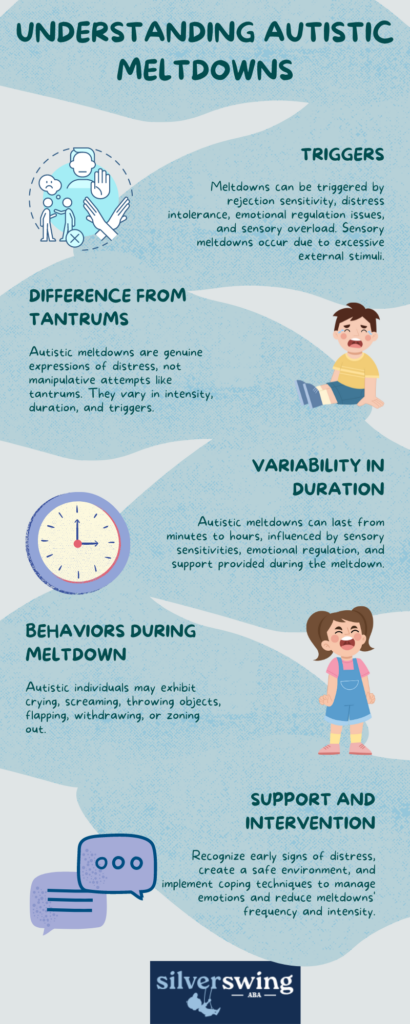Autistic children often face unique challenges, and managing their sensory issues can be particularly difficult. Even those with lower support needs can experience what’s known as an “autistic meltdown,” which is more intense and longer-lasting than a typical tantrum.
As a parent or caregiver, understanding how to calm autistic tantrums is essential for both the child’s well-being and your own peace of mind.

Understanding Autistic Meltdowns
Autistic meltdowns are distinct from temper tantrums in their intensity, duration, and underlying causes. While tantrums are often manipulative attempts to get what a child wants, meltdowns are genuine expressions of distress and dysregulation. These emotional outbursts can manifest in various ways.
The duration of an autistic meltdown can vary widely as well, with some lasting only a few minutes while others may persist for an hour or longer. Factors such as sensory sensitivities, emotional regulation, and the level of support provided during the meltdown can influence its duration and intensity.
What Does An Autistic Meltdown Look Like?
Autistic individuals may exhibit a range of behaviors during a meltdown, including crying, screaming, throwing or breaking objects, flapping or pacing, withdrawing, clenching or grinding teeth, zoning out, etc. These behaviors are not premeditated but are rather involuntary responses to overwhelming stimuli.
Meltdowns can be triggered by various factors, including rejection sensitivity, distress intolerance, emotional regulation issues, and sensory overload. Sensory meltdowns, in particular, occur when there is an excessive amount of external stimuli for the brain to process, such as bright lights, loud noises, or crowded environments.
Understanding the nature of autistic meltdowns is crucial for parents and caregivers in providing appropriate support and intervention strategies. By recognizing early signs of distress, creating a safe and supportive environment, and implementing coping techniques, individuals with autism can better manage their emotions and reduce the frequency and intensity of meltdowns.
To better understand autistic meltdown, learn about early warning signs as well. Watch out for subtle signs like increased agitation, stimming behaviors (repetitive actions like rocking or pacing), or attempts to escape overwhelming stimuli. These signs vary from person to person and situation to situation, so staying observant is vital.
Tools and Techniques for Calming Autistic Tantrums
Managing autistic meltdowns requires a multifaceted approach that combines understanding, patience, and practical strategies. By equipping yourself with effective tools and techniques, you can help create a supportive environment for individuals with autism to navigate overwhelming situations with greater ease.
1. Create a Safe Environment
Designating a quiet and calming space where the child can retreat is essential. This space should be free from excessive sensory stimuli such as bright lights, loud noises, or overwhelming textures. Consider incorporating elements like soft lighting, comfortable seating, and familiar objects to promote relaxation and emotional regulation.
2. Identify Triggers
Understanding the specific triggers that precede meltdowns is crucial for proactive management. Keep a journal or log of events and situations that lead to meltdowns to identify patterns. Once you recognize these triggers, you can implement strategies to avoid or mitigate them, minimizing the likelihood of future meltdowns.
3. Maintain Consistent Routines
Predictability and routine play a significant role in reducing anxiety and promoting emotional stability. Stick to consistent schedules for daily activities, meals, and bedtime routines. Use visual schedules or calendars to help the child anticipate and prepare for upcoming events, fostering a sense of security and control.
4. Use Visual Supports
Visual tools like schedules, cue cards, or pictorial representations can enhance communication and comprehension for individuals with autism. These visual supports provide a tangible representation of tasks, expectations, and transitions, helping to reduce anxiety and confusion. Incorporate them into daily routines to facilitate understanding and independence.
5. Teach Coping Strategies
Collaborate with the child to develop and practice coping techniques tailored to their individual needs. This may include deep breathing exercises, progressive muscle relaxation, or mindfulness techniques. Introduce sensory tools such as fidget toys, stress balls, or textured objects to provide tactile stimulation and promote self-regulation during moments of distress.
6. Provide Calming Aids
Weighted blankets, compression vests, or sensory cushions can offer comforting tactile input and promote relaxation. These calming aids provide gentle pressure to the body, mimicking the sensation of a reassuring hug and helping to soothe heightened emotions. Experiment with different types of calming aids to find what works best.
7. Communication Strategies
Encourage the development of communication skills through alternative methods such as visual communication boards, sign language, or augmentative and alternative communication (AAC) devices. These tools empower individuals with autism to express their needs, preferences, and emotions effectively, reducing frustration and enhancing overall communication.
8. Stay Calm and Supportive
During a meltdown, maintain a calm and supportive demeanor to provide a reassuring presence for the child. Avoid escalating the situation by raising your voice or displaying your frustration. Instead, do your best to offer gentle reassurance, validating the child’s feelings and providing comfort as needed.
9. Allow Time for Recovery
After a meltdown, allow the child sufficient time and space to recover emotionally. Avoid rushing or pressuring them to resume activities immediately. Provide a nurturing environment with opportunities for relaxation and self-soothing activities, allowing the child to regain emotional equilibrium at their own pace.

When to Seek Professional Help
While implementing strategies at home can be beneficial, there are instances where seeking professional guidance may be necessary for managing autistic tantrums effectively. Behavioral therapists and other autism specialists possess expertise in assessing the unique needs of individuals with autism spectrum disorder (ASD).
To find the best professional in your area, consider seeking referrals from your child’s pediatrician, school psychologist, or local autism support groups. Additionally, inquire about their experience working with individuals with ASD, their approach to treatment, and any relevant certifications or credentials.
The Takeaway
Calm autistic tantrums require patience, understanding, and proactive strategies. By recognizing early signs, creating supportive environments, and teaching coping techniques, parents and caregivers can help manage meltdowns effectively.
Seeking professional guidance when needed ensures the child receives the best possible support tailored to their unique needs. With patience and support, tantrums can become more manageable for both the child and their caregivers.
Sources:




